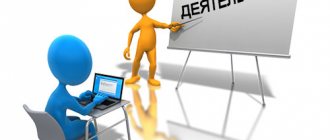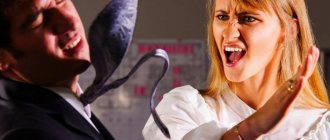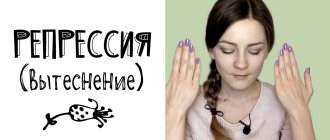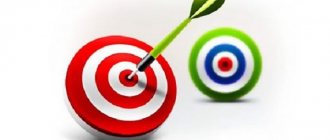Hello everyone, dear readers! I think every person at least once in his life “turned on” Sherlock Holmes when he needed to determine or find out something. I have one friend from the “stop a galloping horse and enter a burning hut” category, who even caught a thief with her bare hands while on vacation. And then she proudly handed herself over to the police. There are people whom you don’t feed with bread - just let them dig into someone, uncover all the “skeletons in the closets.” And it’s great when it really brings benefits. For example, it is useful to detect a “rat” in a department or an unscrupulous accountant. It is useful to hire a person with a suitable set of personal characteristics that meet the requirements. In this article we will talk to you about what profiling is, why it is needed and how to get the necessary information about a person.
COMPLETE LIST OF HUMAN SKILLS
Definition
Profiling is a selection of psychological tools for assessing and predicting human behavior. This is a relatively new direction in psychology, where a trained specialist can analyze verbal and non-verbal personality traits, identify lies without a detector, and determine a person’s further behavior.
The blog already has an article How to recognize a lie: 10 mistakes of lovers of lies and effective ways to identify deception and others that will introduce you to personality psychology. Profiling is based on recognizing a person’s emotions and character. They can be recognized using tests to determine their psychotype, as well as by reading gestures, facial features, facial expressions, speech, and eyes.
Profiling capabilities
Very interesting science. Some people think it's pseudoscience, but I'll give you some data where you can see how profiling has helped with serious problems. Let's dive a little into history.
Interestingly, this method has been used since the end of the 9th century. In 1888, it was first used by surgeon Thomas Bond from England, when he compiled a psychological profile of the serial maniac Jack the Ripper. Therefore, the first area where profiling was used was forensics.
Almost a hundred years later, in 1985, profiling techniques were used to identify and apprehend criminals who committed serious violent crimes. The methods were developed in the USA by Ressler and Brooks. And this direction works to this day and greatly simplifies the work of FBI employees.
This branch of psychology has been adopted by airline employees. You probably know that the favorite place of terrorists is the airport. During pre-flight inspection through questioning and observation of passengers, profiling methods have saved not a single aircraft from an on-board terrorist attack.
Now interested people around the world are learning profiling, since an experienced specialist can detect lies even while talking on the phone. Why not believe in such useful science? Who among you wouldn’t want to spot a scammer or a deceitful person right away?
Today, in Russia and neighboring countries, profiling is actively developing in the HR and security sectors. Specialists monitor the hiring of employees in the company, work with the psychological climate in the team, and the effectiveness of each employee.
The importance of this direction is difficult to overestimate. Profiling is used wherever it is possible to apply it. For example:
- in security, in order to timely identify and prevent illegal actions;
- in large companies, where serious negotiations are constantly carried out in order to spot the “set-up” and deception in time;
- in trading, to calculate discounts, bonuses and benefits for yourself;
- with numerous contacts with other people (administrators, reception staff, etc.);
- in psychology, so as not to bother with psychodiagnostics, but to immediately find out who is standing in front of you.
Areas of application
Areas in which profiling is in demand:
- Forensics. The method allows you to understand the personal characteristics of serial killers and create their psychological portrait. Includes the application of knowledge from criminology, psychiatry and psychology.
- Special direction. During the Soviet Union, the method was used by KGB officers to identify spies. Today, this area is still relevant and deals with the detection of persons prone to terrorism and extremist activities.
- Aviation. In this area, profiling helps to identify potentially dangerous passengers during pre-flight inspection. Today this method is used in almost all airports in the world.
- Research activities. The main person here is Paul Ekman, a famous American psychologist who studied microexpressions and the definition of emotions. It was thanks to his theory that profiling reached a new level of development and began to penetrate other professional areas. Ekman's research became the basis for training programs for security officers in legal, banking, and government organizations.
- Medical and psychological direction. Based on the research of famous psychiatrists Peter Gannushkin and Karl Leonhard, methods were developed that are widely used in modern psychiatry.
- Psychotechnological sphere. It is this area of profiling that underlies NLP (neurolinguistic programming), the goal of which is to improve the effectiveness of communications between people to achieve what they want. Simply put, subtle manipulation techniques.
Types of profiling and their characteristics
Reading people's behavior and emotional states is needed wherever there are people. Therefore, the main types are distributed according to areas of increased danger from criminals to civilians:
- Aviation profiling is the identification by the behavior of passengers which of them has intentions to commit a terrorist attack, offense or hooliganism.
- Zheleznodorozhny – prevention and control of crimes against people on railway transport, in station buildings, and in surrounding areas.
- Hotel - crime prevention techniques in hotels and surrounding areas.
- Criminal – drawing up a psychological portrait of the criminal’s personality for the relevant services.
- Personnel – needed to identify candidates for a position and their compliance with the requirements. It is important that the specialist also checks the candidate’s past: criminal activities, debts, various types of addictions (gaming, drugs, alcohol).
- Audit profiling is the work of a profiler (specialist) in an audit company. He studies not only documents, but also the personalities of employees.
- Data profiling is necessary to prevent theft of funds.
- Banking – needed to minimize losses when issuing loans to private legal entities.
- Insurance – identifying fraudulent schemes in the work of an insurance company.
- Family - determining the level of trust in a partner, developing a feeling that there is reciprocity in the relationship, there is no deception.
Research in the field of automation of profiling today has a different vector.
Profiling based on data from social networks is actively developing, and the analysis of speech and video continues to be improved. The SearchInform team and I are working in a unique direction - profiling based on text evaluation. The module will work as part of the KIB SearchInform DLP system and compile a psychological portrait of the user based on the analysis of the text he creates (messages in instant messengers, emails, comments on the Internet, etc.). The system analyzes the structure of the text and the essence in it, semantic coloring, and also conducts psycholinguistic analysis. As a result, the basic and current values of a person, criminal tendencies and inclinations, the level of conflict, risks and much more are determined. The effectiveness of this technology, like any other, will not reach 100%, but it is absolutely possible to improve the methods to 90-95%.
Profiling tests
When I was not yet planning to enroll to study as a psychologist, I was always interested in taking tests, discovering something new and interesting in myself. And now I see more and more people who want to know about themselves. This is fine! The golden rule of psychology says: “Know yourself and it will be easier to understand others.” Psycho personality type tests help you understand yourself and find out why others behave the way they do.
- What is your psychotype? The test helps to identify your abilities, predispositions, strengths and weaknesses of your character. Contains 36 questions. It will allow you to correctly use your resources in life and develop.
- Myers-Briggs personality type test. The technique allows us to identify a person’s inclinations and characteristics. Defines basic worldviews and decision-making mechanisms.
- Socionics. Test to determine personality type. You have to answer 28 questions. They determine your personality type, how you position yourself in society, the characteristics of your nervous system and interpersonal relationships.
- Leonhard test. Determination of personality type online. The questionnaire consists of 88 questions and helps to thoroughly study the personality. It is used in professional research, as well as in criminology, psychology, and medicine.
How to learn profiling
As we have already decided, everyone wants to understand people! So now is the time to learn how to learn profiling. Often specialists are given only 3-4 minutes to study a person and create a portrait of his personality. And trained profilers cope with this using special methods.
Profiling technologies include several areas:
- Primary study - establishing contact, briefly explaining to the person why the questions are being asked.
- Inspection – recording a person’s appearance and behavior, special attention is paid to non-standard moments and deviations.
- Drawing up a psychological portrait - identifying signs of fear, aggression, depression, focusing on personality traits.
- Checking documents - detecting signs of forgery.
- Conversation – standard questions to obtain the necessary information, especially regarding a person’s goals and plans.
These technologies address the area of profiling where security needs to be ensured. In everyday life, there are also several techniques that help “read” a person on the spot.
TOZ (points of approximate freezing) in profiling is a technique for determining lies based on a person’s physiological reaction. This is a pause that occurs when a person thinks about what to say. When asked uncomfortable questions, he tenses up, thinks over the answer longer, freezes a little (his gaze stops, his breathing freezes, his movements “freeze”).
A lie is always a conscious choice, so in the TOZ a decision is made: to lie or not to lie. This is a kind of flag for detecting lies, but TOZ is not an exact guarantee of deception. This only indicates that the person was thinking whether to tell the truth or a lie. To determine TOZ, you need to ask a simple question, then a complex one: “What is your wife’s name?”, “Have you identified the shortage today?”
Determining personality type based on messages on social networks. This is a new direction that is just being developed. To achieve this, new technologies are being used that automatically determine a person’s psychotype.
So, we come to the training materials on creating a personality profile. To understand the secrets of personality and become more familiar with the techniques of “reading” a person, you can study the list of books on profiling. Literature will help you figure out what signs to recognize different human emotions.
There are also meaningful profiling training courses available. They help you learn not only theory, but also practice “reading” and understanding a person in practice.
Profiling - a course on reading people from Vikium. It consists of 20 lessons. Includes a set of practical methods for reading non-verbal words, tools for practicing new knowledge, simulators for recognizing microexpressions, tests that check the level of skill proficiency.
Will help:
- Anticipate a person's actions in negotiations.
- Identify fake emotions.
- Recognize signals of deception at the non-verbal level.
- Predict people's actions.
- Detect deception in writing.
Cost – 990 rub. After completing the training, it will not be difficult for you to distinguish between attempts to manipulate and see through people.
Examples and interpretation of gestures and speech
And here’s where the fun begins – let’s look a little deeper into human psychology. In the section of examples, I will reveal several secrets on the operational diagnosis of a person, how to understand that they are trying to “cheat” you.
It is important to remember that deception always entails a chain of gestures, so the veracity of the information cannot be judged by just one of them. So, a person is lying to you when he displays the following gestures:
- touches the tip of the nose - here it is the tip that matters, since other parts of the organ have a different meaning;
- uncontrolled movements of the hands near the face (stroking the lips, forehead, temples, chin, rubbing the eyelid, lips, covering the mouth with the hand);
- tries to maintain a distance from the interlocutor (leaning his body away from the person, stepping back, moving away, crossing his legs under the chair);
- quickly rubbing hands is just that, fast, because if a person does it slowly, then the meaning changes radically;
- he pulls his legs under him and taps them on the floor.
The following verbal signs may indicate hypocrisy:
- Generalization of facts, concealment of essential details, presentation of information one-sided.
- Only short sentences are heard in speech, so as not to forget all the adjectives and adverbs that were carelessly added.
- A minimum of direct answers, constantly trying to evade: “I’m not the type to...”, “I think it shouldn’t be so one-sided...”
- An abundance of peremptory remarks like “I won’t tell anyone...”, “I won’t do anything...”, thereby trying to make you trust him.
- Changes the pace of speech, the hypocrite, pondering the presentation of information, slows down in his comments, and then, so as not to forget what he said, quickly speeds up.
- Repeats your words, for example: “Were you in the cafe yesterday?” - “Was I in the cafe yesterday? Yes". This is done in order to adapt to you and reduce your vigilance.
These interesting data about liars and hypocrites can be useful to you in negotiations or when communicating with unfamiliar people.
And in addition, watch this interesting video:
Myth or truth
The emergence of myths about profiling is directly related to fiction, since many often judge the work of criminologists and psychologists solely on films and TV series like “Lie to Me,” “The Mentalist,” or “Sherlock.” Thus, opinions on profiling are divided: some believe that by the gestures and gaze of the interlocutor when answering, one can accurately and easily identify a liar and a criminal. Others are suspicious of profiling because they do not believe that it has a sufficient theoretical basis.
Let's look at this case: at an interview, an HR specialist with a sweet smile asks the applicant: “What do you like to do in your free time?” A trivial question, isn't it? The future employee most likely thought the same thing and, without hesitation, answered: “Watch movies, walk in the park and occasionally read scientific literature.” At the same time, a small note: during the answer, the candidate scratched his nose and looked to the left. The recruiter, who carefully monitored the interlocutor’s gestures, came to the conclusion that he was lying. The interview failed. The next day, the candidate went to another interview, where he answered in exactly the same way and with the same gestures, but he was accepted. Why is that?
Perhaps the first recruiter did not take into account the fact that the candidate may be allergic and look to the left because she imagined him lying on the couch, and not because he wants to deceive her or is insincere in his answers.
Or another situation: a person pats himself on the shoulder, answering the question why he wants to work in this company. The recruiter notices this and casually asks: “Why are you nervous?”, to which the candidate replies that his dream is to work in this company. How did HR determine the meaning of this gesture? The fact is that stroking oneself is a person’s attempt to calm down and show himself that he is safe.
There are many myths around profiling, supported by the media, but this does not mean that its methods cannot be used in personnel selection. For example, a candidate’s raised eyebrows in response to the recruiter’s question “Why did you come to us?” can be more eloquent than any words, since it will tell more about his temperament.
In addition, understanding a person’s gestures, postures and facial expressions can help establish communication with a new person in a team and understand his attitude to a certain situation.
FAQ
Will I be able to read people after learning profiling?
To “read” people, it is not enough just to read an intelligent book. To “scan” a person you need to know the basics of psychology and be able to observe. Only in this case will it be possible to find out about a person what he is hiding.
Is it possible to determine by gestures whether a person will set me up or not?
Will he set you up or won't you set him up, no gestures are shown. But, knowing the basics of profiling, you will be able to predict a person’s behavior: whether he is deceiving you, whether he is ready to sincerely communicate with you or not. This science provides such data.
Will knowing profiling make my life easier?
This knowledge is universal. And they really make life easier. Forecast and knowledge of human psychology help prevent some mistakes or, conversely, provoke him to openness. You need to develop and study profiling even for everyday life.
What qualities should a profiler have?
- good memory;
- attention to detail;
- ability to analyze;
- honesty;
- control of emotions;
- resistance to stressful situations;
- good speech and diction;
- intelligent manners;
- the ability to find an approach to people, talk, get the necessary information;
- good intellectual development;
Profilers must be versatile, be able to find an approach to people, and conduct a conversation correctly.
What a profiler should know
- interpersonal communication, negotiations
- nonverbal communication, gestures, microexpressions
- psychology and physiology, including personal, emotional, psychology of deception
- modern technologies
By the way, the profiler has quite a lot of colleagues with similar professions. If you find yours, it may be easier for you to gain a new skill and retrain.
These are professions such as:
- polygraph examiner
- psychiatrist, psychologist, psychotherapist
- teacher
- HR
- investigator, detective, security service, traffic police officer and other law enforcement officers










